© 2014-


Radio Noordzee - History
Towards the end of 1963 elaborate plans were being made for a new radio and television station based, not on a ship, but on a man-
Businessman I. P. Heerema and Rotterdam shipbuilder Cornelis (Cor) Verolme, together with business colleagues Joseph Brandel and M Minderop formed a company -
The company's main objective was to provide an offshore commercial television service for a large area of Holland, hence the need for a stable structure from which to operate. Their oil platform style structure, which became known as the REM Island, was unique in offshore broadcasting history, being purpose designed and built in prefabricated sections, using the shipbuilding experience and facilities of a yard in Cork, Ireland owned by Cor Verolme. He had worked in the offshore oil industry in Curacao, Aruba and Venezuela. The REM Island was an exact copy of oil rigs used in the Lago di Maracaibo, on the north coast of Venezuela.
The prefabricated se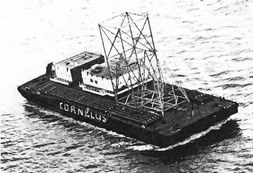 ctions were transported from Ireland and construction of the 'Island' was completed during the night of 4/5th June 1964. Broadcasting equipment was then installed by communications giants RCA.
ctions were transported from Ireland and construction of the 'Island' was completed during the night of 4/5th June 1964. Broadcasting equipment was then installed by communications giants RCA.
Test transmissions for the radio station on board REM Island started on 19th July 1964 and, following an opening announcement in English, regular broadcasts under the call sign Radio Noordzee started in Dutch on 23rd July 1964. Tests broadcasts from TV Noordzee started on 12th August 1964, with regular programmes from 1st September.
The Dutch Government, which since 1960 had been remarkably tolerant of Radio Vero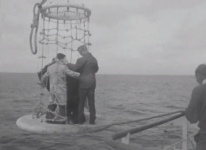 nica's broadcasts, took an entirely different view about the new, more powerful television and radio station located on the REM Island. They were furious that such a powerful broadcaster could establish what appeared to be a permanent base off the coast and beam programmes to millions of Dutch homes. Although Radio and TV Noordzee programmes were confined to entertainment the Government really feared that the REM Island transmitter, or another similar operation, could be used for political propaganda purposes.
nica's broadcasts, took an entirely different view about the new, more powerful television and radio station located on the REM Island. They were furious that such a powerful broadcaster could establish what appeared to be a permanent base off the coast and beam programmes to millions of Dutch homes. Although Radio and TV Noordzee programmes were confined to entertainment the Government really feared that the REM Island transmitter, or another similar operation, could be used for political propaganda purposes.
On 16th September 1964 the Lower House of the Dutch Parliament began to discuss the situation and the following day it was decided to introduce legislation which would bring the artificial island within D utch territorial limits.
utch territorial limits.
In order to achieve this objective the Government proposed to rely on the 1958 United Nations Geneva Convention, which defined the limits of a 'continental shelf' over which coastal states could exercise sovereignty. Under this Convention a country could extend its boundaries out to sea for a distance of up to 200 miles, relying on the extent to which the submerged landmass ('continental shelf') adjoining the coast projected seawards. Any physical structure supported by part of the sea-
With the new legislation about to be introduced in late 1964 ownership of REM Island was transferred to Expoitatacion De Construcciones Martitima Excomarsa (registered in Panama) and broadcasting rights for Radio and TV Noordzee were transferred to a British company, High Seas Television Ltd., of London
At about the same time the assets of REM were transferred to a new organisation -
Meanwhile the Dutch Government vigorously pursued its opposition to the offshore radio and television stations housed on the REM Island and legislation giving effect to an extension of sovereignty over the continental shelf (and any structures built on it) was passed in the Dutch Senate on 1st December 1964, becoming law twelve days later. The new law had been designed specifically to close Radio and TV Noordzee and did not apply to Radio Veronica, which by December 1964 had been on the air for four and a half years, because that was a ship-
TV Noordzee ceased transmissions on 14th December 1964 but Radio Noordzee did continue to defy the new law. After five days the Dutch authorities decided to act -
The Dutch Nav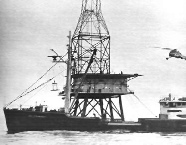 al vessel, Delftshaven took up position 200 yards from the REM Island at 8.55am on 17th December 1964. Five minutes later three helicopters appeared and hovered overhead, the first dropped a marker flare onto the rooftop helipad and at 9.03am the other two landed a force of armed police on the artificial Island. At 9.07am transmissions of Radio Noordzee were abruptly silenced by the authorities during a programme presented by Sonja van Proosdjijk, the last record being played was Paradiso by Anneke Gronloh.
al vessel, Delftshaven took up position 200 yards from the REM Island at 8.55am on 17th December 1964. Five minutes later three helicopters appeared and hovered overhead, the first dropped a marker flare onto the rooftop helipad and at 9.03am the other two landed a force of armed police on the artificial Island. At 9.07am transmissions of Radio Noordzee were abruptly silenced by the authorities during a programme presented by Sonja van Proosdjijk, the last record being played was Paradiso by Anneke Gronloh.

The prefabricated sections of REM Island being towed from Ireland to The Netherlands
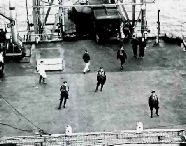
Two views of the Police raid on REM Island, December 1964

Click on picture to enlarge

Daily Express
18th December 1964

The Sun
18th December 1964

History
Key Dates
Base and Location



Technical
Staff


Programmes
Crew members arriving on board REM Island
Photo: Hans Knot
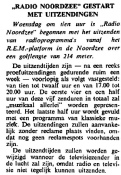
Gereformeerd Gosinsblad
30th July 1964
(Start of transmissions)
Courtesy Hans Knot
Demonstration outside the Dutch Parliament in support of Radio/TV Noordzee
Photo: Hans Knot

Back to Radio Noordzee


Back to Netherlands/Belgium Gallery

